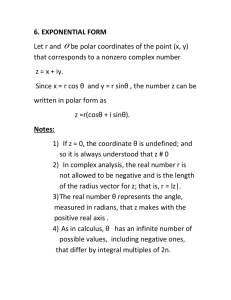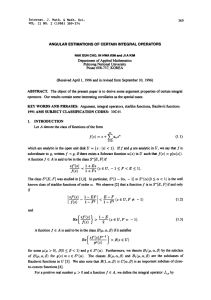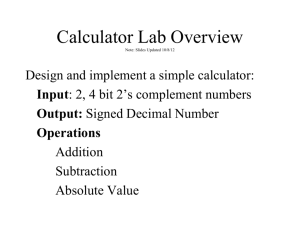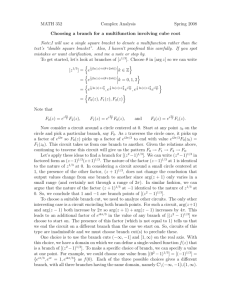CERTAIN INTEGRAL OPERATOR AND STRONGLY STARLIKE FUNCTIONS JIN-LIN LIU
advertisement
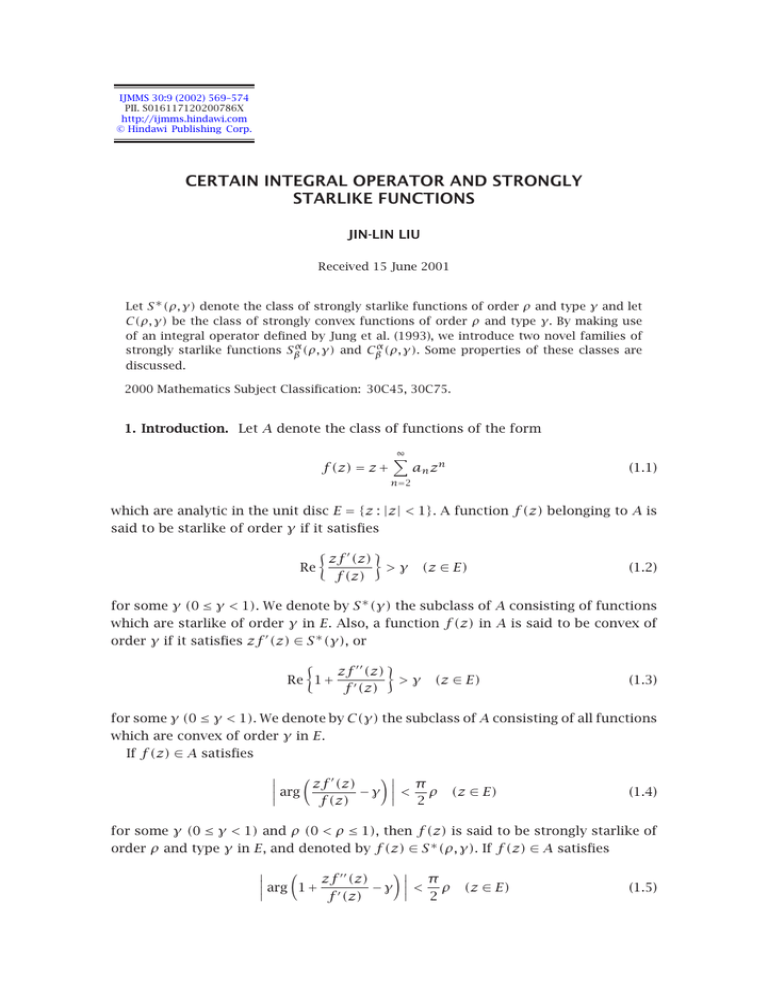
IJMMS 30:9 (2002) 569–574
PII. S016117120200786X
http://ijmms.hindawi.com
© Hindawi Publishing Corp.
CERTAIN INTEGRAL OPERATOR AND STRONGLY
STARLIKE FUNCTIONS
JIN-LIN LIU
Received 15 June 2001
Let S ∗ (ρ, γ) denote the class of strongly starlike functions of order ρ and type γ and let
C(ρ, γ) be the class of strongly convex functions of order ρ and type γ. By making use
of an integral operator defined by Jung et al. (1993), we introduce two novel families of
strongly starlike functions Sβα (ρ, γ) and Cβα (ρ, γ). Some properties of these classes are
discussed.
2000 Mathematics Subject Classification: 30C45, 30C75.
1. Introduction. Let A denote the class of functions of the form
f (z) = z +
∞
an zn
(1.1)
n=2
which are analytic in the unit disc E = {z : |z| < 1}. A function f (z) belonging to A is
said to be starlike of order γ if it satisfies
Re
zf (z)
f (z)
>γ
(z ∈ E)
(1.2)
for some γ (0 ≤ γ < 1). We denote by S ∗ (γ) the subclass of A consisting of functions
which are starlike of order γ in E. Also, a function f (z) in A is said to be convex of
order γ if it satisfies zf (z) ∈ S ∗ (γ), or
zf (z)
Re 1 + >γ
f (z)
(z ∈ E)
(1.3)
for some γ (0 ≤ γ < 1). We denote by C(γ) the subclass of A consisting of all functions
which are convex of order γ in E.
If f (z) ∈ A satisfies
arg zf (z) − γ < π ρ
f (z)
2
(z ∈ E)
(1.4)
for some γ (0 ≤ γ < 1) and ρ (0 < ρ ≤ 1), then f (z) is said to be strongly starlike of
order ρ and type γ in E, and denoted by f (z) ∈ S ∗ (ρ, γ). If f (z) ∈ A satisfies
arg 1 + zf (z) − γ < π ρ
f (z)
2
(z ∈ E)
(1.5)
570
JIN-LIN LIU
for some γ (0 ≤ γ < 1) and ρ (0 < ρ ≤ 1), then we say that f (z) is strongly convex
of order ρ and type γ in E, and we denote by C(ρ, γ) the class of such functions. It is
clear that f (z) ∈ A belongs to C(ρ, γ) if and only if zf (z) ∈ S ∗ (ρ, γ). Also, we note
that S ∗ (1, γ) = S ∗ (γ) and C(1, γ) = C(γ).
For c > −1 and f (z) ∈ A, we recall the generalized Bernardi-Libera-Livingston integral operator Lc (f ) as
Lc (f ) =
c +1
zc
z
0
t c−1 f (t)dt.
(1.6)
The operator Lc (f ) when c ∈ N = {1, 2, 3, . . .} was studied by Bernardi [1]. For c = 1,
L1 (f ) was investigated by Libera [4].
Recently, Jung et al. [2] introduced the following one-parameter family of integral
operators:
Qβα f (z) =
α+β α z
t α−1 β−1
t
f (t)dt
1−
β
β
z 0
z
(α > 0, β > −1, f ∈ A).
(1.7)
They showed that
Qβα f (z) = z +
∞
Γ (β + n)Γ (α + β + 1)
an zn ,
Γ (β + α + n)Γ (β + 1)
n=2
(1.8)
where Γ (x) is the familiar Gamma function. Some properties of this operator have
been studied (see [2, 3]). From (1.7) and (1.8), one can see that
z Qβα+1 f (z) = (α + β + 1)Qβα f (z) − (α + β)Qβα+1 f (z).
(1.9)
It should be remarked in passing that the operator Qβα is related rather closely to the
Beta or Euler transformation.
Using the operator Qβα , we now introduce the following classes:
Sβα (ρ, γ)
= f (z) ∈ A :
Qβα f (z)
∗
∈ S (ρ, γ),
z Qβα f (z)
Qβα f (z)
≠ γ ∀z ∈ E ,
α
z Qβ f (z)
α
α
Cβ (ρ, γ) = f (z) ∈ A : Qβ f (z) ∈ C(ρ, γ), α
≠ γ ∀z ∈ E .
Qβ f (z)
(1.10)
It is obvious that f (z) ∈ Cβα (ρ, γ) if and only if zf (z) ∈ Sβα (ρ, γ).
In this note, we investigate some properties of the classes Sβα (ρ, γ) and Cβα (ρ, γ).
The basic tool for our investigation is the following lemma which is due to Nunokawa
[5].
Lemma 1.1. Let a function p(z) = 1 + c1 z + c2 z2 +· · · be analytic in E and p(z) ≠ 0
(z ∈ E). If there exists a point z0 ∈ E such that
arg p(z) < π ρ
2
|z| < z0 ,
arg p z0 = π ρ
2
(0 < ρ ≤ 1),
(1.11)
CERTAIN INTEGRAL OPERATOR AND STRONGLY STARLIKE FUNCTIONS
571
then
z0 p z0
= ikρ,
p z0
(1.12)
π
1
1
a+
when arg p z0 = ρ ,
2
a
2
1
1
π
k≤−
a+
when arg p z0 = − ρ ,
2
a
2
(1.13)
where
k≥
and p(z0 )1/ρ = ±ia (a > 0).
2. Main results. Our first inclusion theorem is stated as follows.
Theorem 2.1. The class Sβα (ρ, γ) ⊂ Sβα+1 (ρ, γ) for α > 0, β > −1, 0 ≤ γ < 1 and
α + β ≥ −γ.
Proof. Let f (z) ∈ Sβα (ρ, γ). Then we set
z Qβα+1 f (z)
Qβα+1 f (z)
= (1 − γ)p(z) + γ,
(2.1)
where p(z) = 1+c1 z +c2 z2 +· · · is analytic in E and p(z) ≠ 0 for all z ∈ E. Using (1.9)
and (2.1), we have
(α + β + 1)
Qβα f (z)
Qβα+1 f (z)
= (α + β + γ) + (1 − γ)p(z).
(2.2)
Differentiating both sides of (2.2) logarithmically, it follows from (2.1) that
z Qβα f (z)
Qβα f (z)
− γ = (1 − γ)p(z) +
(1 − γ)zp (z)
.
(α + β + γ) + (1 − γ)p(z)
(2.3)
Suppose that there exists a point z0 ∈ E such that
arg p(z) < π ρ
2
|z| < z0 ,
arg p z0 = π ρ.
2
(2.4)
Then, by applying Lemma 1.1, we can write that z0 p (z0 )/p(z0 ) = ikρ and that
(p(z0 ))1/ρ = ±ia (a > 0).
Therefore, if arg p(z0 ) = −(π /2)ρ, then
z0 Qβα f z0
z0 p z0 /p z0
−
γ
=
(1
−
γ)p
z
1
+
0
Qβα f z0
(α + β + γ) + (1 − γ)p z0
ρ −iπ ρ/2
= (1 − γ)a e
ikρ
1+
.
(α + β + γ) + (1 − γ)aρ e−iπ ρ/2
(2.5)
572
JIN-LIN LIU
From (2.5) we have
α z 0 Qβ f z 0
arg
−
γ
Qβα f z0
ikρ
π
= − ρ + arg 1 +
2
(α + β + γ) + (1 − γ)aρ e−iπ ρ/2
πρ
π
kρ (α + β + γ) + (1 − γ)aρ cos
= − ρ + tan−1
2
2
πρ
× (α + β + γ)2 + 2(α + β + γ)(1 − γ)aρ cos
2
−1 π
ρ
+ (1 − γ)2 a2ρ − kρ(1 − γ)aρ sin
2
≤−
(2.6)
π
ρ,
2
where k ≤ −(1/2)(a + 1/a) ≤ −1, α + β ≥ −γ, which contradicts the condition f (z) ∈
Sβα (ρ, γ).
Similarly, if arg p(z0 ) = (π /2)ρ, then we have
arg
z0 Qβα f z0
π
− γ ≥ ρ,
Qβα f z0
2
(2.7)
which also contradicts the hypothesis that f (z) ∈ Sβα (ρ, γ).
Thus the function p(z) has to satisfy | arg p(z)| < (π /2)ρ (z ∈ E), which leads us
to the following:
α+1
π
z Qβ f (z)
< ρ (z ∈ E).
arg
(2.8)
−
γ
α+1
2
Q
f (z)
β
This evidently completes the proof of Theorem 2.1.
We next state the following theorem.
Theorem 2.2. The class Cβα (ρ, γ) ⊂ Cβα+1 (ρ, γ) for α > 0, β > −1, 0 ≤ γ < 1, and
α + β ≥ −γ.
Proof. By definition (1.10), we have
f (z) ∈ Cβα (ρ, γ) ⇐⇒ Qβα f (z) ∈ C(ρ, γ) ⇐⇒ z Qβα f (z) ∈ S ∗ (ρ, γ)
⇐⇒ Qβα zf (z) ∈ S ∗ (ρ, γ) ⇐⇒ zf (z) ∈ Sβα (ρ, γ)
⇒ zf (z) ∈ Sβα+1 (ρ, γ) ⇐⇒ Qβα+1 zf (z) ∈ S ∗ (ρ, γ)
⇐⇒ z Qβα+1 f (z) ∈ S ∗ (ρ, γ) ⇐⇒ Qβα+1 f (z) ∈ C(ρ, γ)
(2.9)
⇐⇒ f (z) ∈ Cβα+1 (ρ, γ).
The following theorem involves the generalized Bernardi-Libera-Livingston integral
operator Lc (f ) given by (1.6).
CERTAIN INTEGRAL OPERATOR AND STRONGLY STARLIKE FUNCTIONS
573
Theorem 2.3. Let c > −γ and 0 ≤ γ < 1. If f (z) ∈ A and z(Qβα Lc f (z)) /Qβα Lc f (z)
≠ γ for all z ∈ E, then f (z) ∈ Sβα (ρ, γ) implies that Lc (f ) ∈ Sβα (ρ, γ).
Proof. Let f (z) ∈ Sβα (ρ, γ). Put
z Qβα Lc f (z)
Qβα Lc f (z)
= γ + (1 − γ)p(z),
(2.10)
where p(z) is analytic in E, p(0) = 1 and p(z) ≠ 0 (z ∈ E). From (1.6) we have
z Qβα Lc f (z) = (c + 1)Qβα f (z) − cQβα Lc f (z).
(2.11)
Using (2.10) and (2.11), we get
(c + 1)
Qβα f (z)
Qβα Lc f (z)
= (c + γ) + (1 − γ)p(z).
(2.12)
Differentiating both sides of (2.12) logarithmically, we obtain
z Qβα f (z)
(1 − γ)zp (z)
− γ = (1 − γ)p(z) +
.
α
Qβ f (z)
(c + γ) + (1 − γ)p(z)
Suppose that there exists a point z0 ∈ E such that
arg p(z) < π ρ
arg p z0 = π ρ.
|z| < z0 ,
2
2
(2.13)
(2.14)
Then, applying Lemma 1.1, we can write that z0 p (z0 )/p(z0 ) = ikρ and (p(z0 ))1/ρ =
±ia (a > 0).
If arg p(z0 ) = (π /2)ρ, then
z0 Qβα f z0
z0 p z0 /p z0
− γ = (1 − γ)p z0 1 +
Qβα f z0
(c + γ) + (1 − γ)p z0
(2.15)
ikρ
ρ iπ ρ/2
= (1 − γ)a e
1+
.
(c + γ) + (1 − γ)aρ eiπ ρ/2
This shows that
α z 0 Qβ f z 0
−γ
arg
Qβα f z0
ikρ
π
= ρ + arg 1 +
2
(c + γ) + (1 − γ)aρ eiπ ρ/2
πρ
π
kρ (c + γ) + (1 − γ)aρ cos
= ρ + tan−1
2
2
πρ
× (c + γ)2 + 2(c + γ)(1 − γ)aρ cos
2
2
2ρ
+ (1 − γ) a
≥
πρ
+ kρ(1 − γ)a sin
2
ρ
(2.16)
−1 π
ρ,
2
where k ≥ (1/2)(a + 1/a) ≥ 1, which contradicts the condition f (z) ∈ Sβα (ρ, γ).
574
JIN-LIN LIU
Similarly, we can prove the case arg p(z0 ) = −(π /2)ρ. Thus we conclude that the
function p(z) has to satisfy | arg p(z)| < (π /2)ρ for all z ∈ E. This shows that
α
π
z Qβ Lc f (z)
< ρ
arg
−
γ
α
Qβ Lc f (z)
2
(z ∈ E).
(2.17)
The proof is complete.
Theorem 2.4. Let c > −γ and 0 ≤ γ < 1. If f (z) ∈ A and (z(Qβα Lc f (z)) ) /
(Qβα Lc f (z)) ≠ γ for all z ∈ E, then f (z) ∈ Cβα (ρ, γ) implies that Lc (f ) ∈ Cβα (ρ, γ).
Proof. Using the same method as in Theorem 2.2 we have
f (z) ∈ Cβα (ρ, γ) ⇐⇒ zf (z) ∈ Sβα (ρ, γ) ⇒ Lc zf (z) ∈ Sβα (ρ, γ)
⇐⇒ z Lc f (z) ∈ Sβα (ρ, γ) ⇐⇒ Lc f (z) ∈ Cβα (ρ, γ).
(2.18)
References
[1]
[2]
[3]
[4]
[5]
S. D. Bernardi, Convex and starlike univalent functions, Trans. Amer. Math. Soc. 135 (1969),
429–446.
I. B. Jung, Y. C. Kim, and H. M. Srivastava, The Hardy space of analytic functions associated
with certain one-parameter families of integral operators, J. Math. Anal. Appl. 176
(1993), no. 1, 138–147.
J. L. Li, Some properties of two integral operators, Soochow J. Math. 25 (1999), no. 1, 91–96.
R. J. Libera, Some classes of regular univalent functions, Proc. Amer. Math. Soc. 16 (1965),
755–758.
M. Nunokawa, On properties of non-Carathéodory functions, Proc. Japan Acad. Ser. A Math.
Sci. 68 (1992), no. 6, 152–153.
Jin-Lin Liu: Department of Mathematics, Yangzhou University, Yangzhou 225002,
Jiangsu, China

